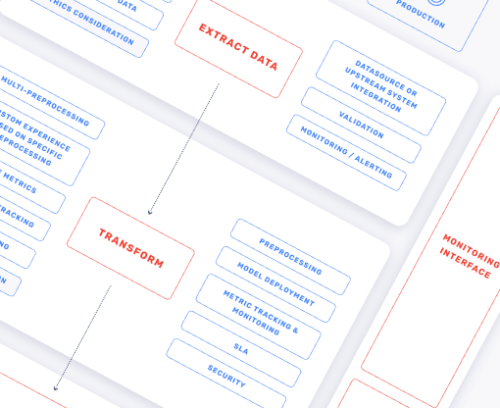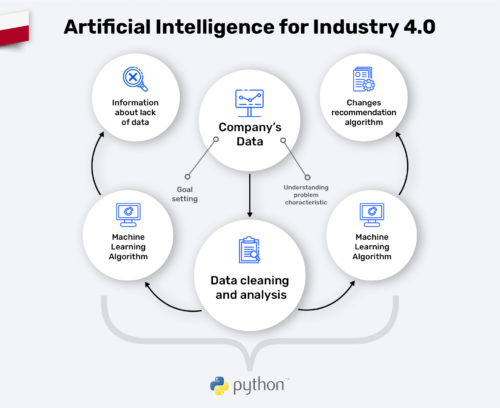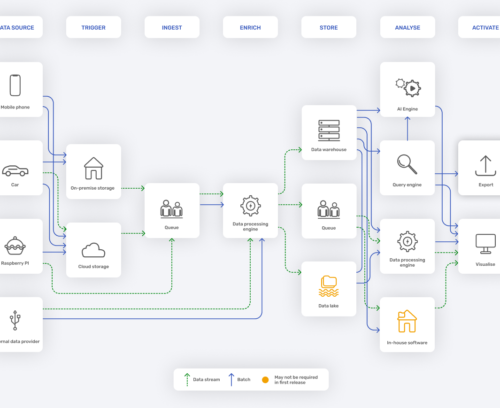Client
PERMITS to Fly is the world’s first automated system that applies for and obtains overflight and landing permits.
Challenge
A management system always requires a lot of work and is time-consuming. Especially in industries where safety factors lengthen the entire process. What if you could automate this procedure and save your precious time?
Project goals
A client, PERMITS to Fly, came to us with an idea. Based on their many years of experience in the aviation industry, they decided to create a digital product that would automate the permit application process. All are based on ICAO and IATA standards. The question was how to create a reliable and useful solution that would meet all the requirements of such a demanding industry?
Services
Product Consulting
UX/UI
Custom Software Development
AI Consulting
Technologies

#PRODUCT DESIGN #CUSTOM SOFTWARE DEVELOPMENT
The story of idea crafted into a valuable product
A management system always requires a lot of work and is time-consuming. Especially in industries where safety factors lengthen the entire process. What if you could automate this procedure and save your precious time?
Project goals
A client, PERMITS to Fly, came to us with an idea. Based on their many years of experience in the aviation industry, they decided to create a digital product that will automate the permit application process. All based on ICAO and IATA standards. The question was how to create a reliable and useful solution that would meet all the requirements of such a demanding industry?

What are the main challenges in the aviation industry?
International flights require landing and overflight permits. Currently, all documentation is created manually, which increases the possibility of human error. The consequences of incorrect applications are very serious, such as delays and flight cancellations. This generates huge losses and becomes a big problem.
- 3,000 permits are obtained or corrected every year, of which one carrier is approximately 80 aircrafts.
- Each permit is an average of 3 documents, which require 10, 000 documents and 11, 000 working hours.
Stepwise was asked to support the vision of the client and to meet the needs of key audiences. The main goal was to create a solution that would solve the problem of creating permits manually. The client, PERMITS to Fly, had an idea and our Product Design team had the knowledge to evolve it into a valuable product. Curious about how we did it?
Scope
The process which brings benefits
Step 1: Discover true needs
We believe that the key to provide the best solution is to truly understand the needs. We started with getting to know the client’s requirements and exploring the problem. For this purpose, we conducted kick-off workshops with the client.
Based on the collected requirements, we created User Personas which allow us to better empathize with the users. In the next step we also went through the User Journey Map in order to define the strengths and weaknesses of the application process.

Key insights
During the Discovery phase we gathered enough knowledge for us to group and identify areas to streamline the entire process of obtaining flight permits.
- The permit application process is time-consuming and complicated.
- All documentation is created manually, which increases the possibility of human error.
- The varied requirements and standards in individual countries substantially hinder the application process.
- There is a strong need to automate the process and ensure better communication at each step of the application process.
Step 2: Design and testing
After establishing the clear goals with the client during the workshops, we began the Design phase. We created a detailed User Flow and based on it we entered the wireframing process in which we commenced designing the process of applying for aviation approvals.
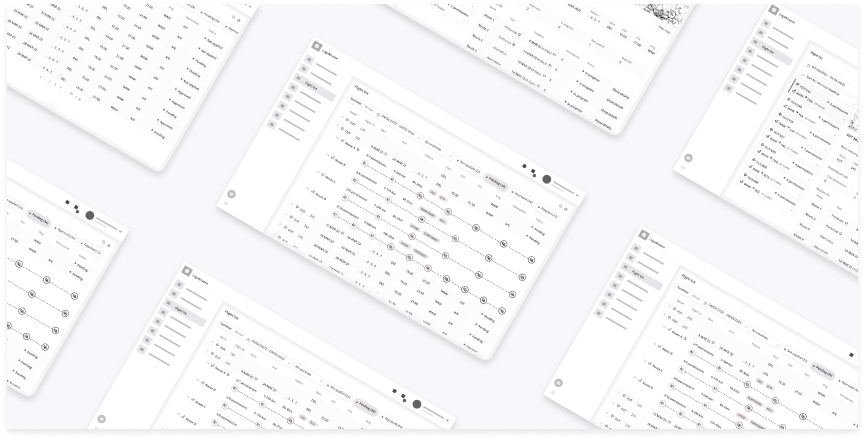
After validation of the first sketches and ideas we started creating hi-fi designs that were both functional and user-friendly. Everything was up to date in close cooperation with the client to correctly verify the knowledge provided.
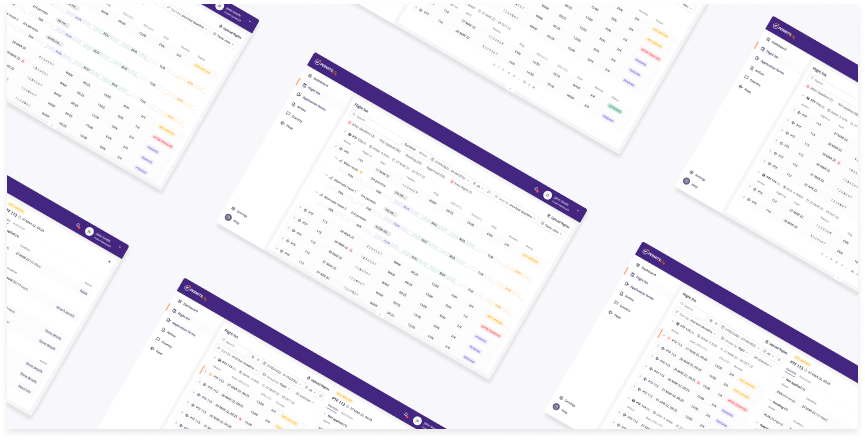
Testing before investing
During the second phase we implemented usability tests to examine the designed solution with the target group.
We tested the main flow of the application process. During the sessions we evaluated the intuitiveness of the application and features like filters and search. We also focused on the navigation and system of status points, which is a crucial aspect of the whole application.
Why are usability tests so important?
Usability tests ultimately confirm the usefulness of the application. Before any line of code was created, we already knew that the designed application was intuitive, fast and understandable. You can read some of the observations we gathered during usability-testing sessions:
“The application process is simple, easy and intuitive.”
“The application itself is intuitive, two clicks and the permit application is ready.”
Step 3: Deliver
The final stage was to deliver the interactive prototype for the client, which included key functionalities for the potential users. Based on findings from the Usability Testing we also updated the final designs and some recommendations that we would like to test in the next iteration. Prepared prototypes are ready to be handed over to the development team.
What are the next steps?
After the first iteration of the product design we are planning further workshops with the client. We want to define the MVP scope for implementation and prioritize features. The main part of this workshop is preparation of the initial developer estimation and detailed discussion of the designed functionalities with the Developer team. We are very happy that the project is gaining momentum and that we can continue to be part of it.
Results
- Cost savings of up to 90% by eliminating expensive manual labor costs.
- Time savings of up to 80% by reducing human intervention during manual processes such as filling out forms or checking boxes
What are the benefits of PERMITS to Fly?
We’ve created an automated system for PERMITS to Fly that streamlines and automates the entire process of obtaining flight permits.
#INTUITIVE APPLICATION PROCESS
We’ve created an intuitive interface that allows users to apply for permits without needing extensive training on new software:
- reducing the possibility of costly errors by eliminating manual data entry
- lowering stress levels by providing instant visual feedback on each step of the process
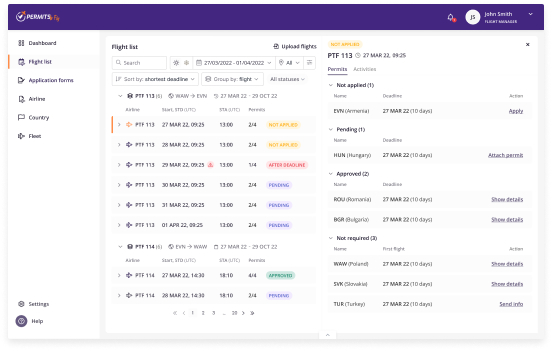

#ADVANCED MONITORING SYSTEM
The key part of the application is monitoring capabilities that allow Permits to Fly to track every application as it progresses through various stages. In this way we can:
- better monitoring and work managing of the entire team
- respond faster to changes in the flight schedule
- easily detect issues at each step of the permit application
#FAST COMMUNICATION SYSTEM
The proposed solution allows team to better and more effective collaboration through the use of:
- simple tasks prioritization system
- monitoring of the team’s work and progress
- implementation of the internal system communication (sharing comments and ability to access the detailed activity history)
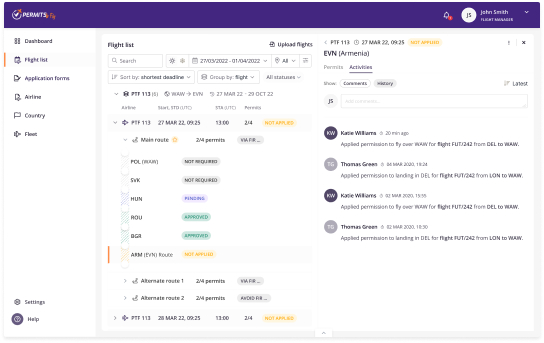
#INTUITIVE APPLICATION PROCESS
We’ve created an intuitive interface that allows users to apply for permits without needing extensive training on new software:
- reducing the possibility of costly errors by eliminating manual data entry
- lowering stress levels by providing instant visual feedback on each step of the process

#ADVANCED MONITORING SYSTEM
The key part of the application is monitoring capabilities that allow Permits to Fly to track every application as it progresses through various stages. In this way we can:
- better monitoring and work managing of the entire team
- respond faster to changes in the flight schedule
- easily detect issues at each step of the permit application

#FAST COMMUNICATION SYSTEM
The proposed solution allows team to better and more effective collaboration through the use of:
- simple tasks prioritization system
- monitoring of the team’s work and progress
- implementation of the internal system communication (sharing comments and ability to access the detailed activity history)

